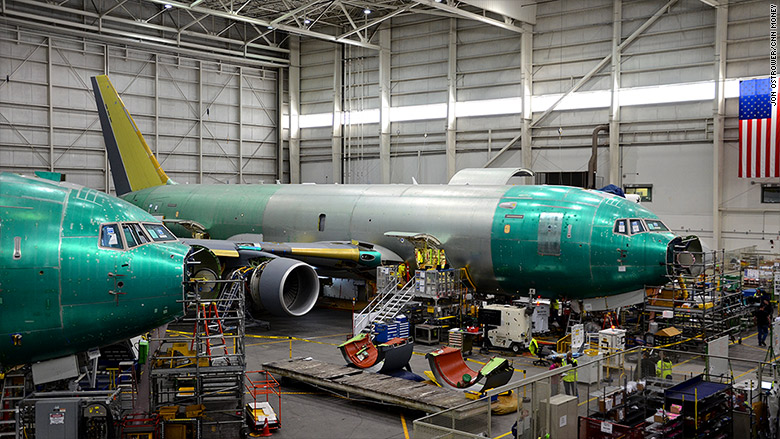
Boeing is set to deliver a refueling tanker that can gas up a jet in midair in complete darkness -- the first of its kind.
The U.S. Air Force is buying 179of the new KC-46 'Pegasus' tankers, which are set to begin delivery at the end of this year.
The Air Force has had stealthy jets for decades, but even they have to turn on their lights when refueling in the sky. The KC-46's ability to gas up an aircraft in complete darkness is a first for any military.
The new jet is part of a $44 billion program to begin replacing hundreds of the Air Force's KC-135 tankers, which have been flying since the Eisenhower Administration.
Boeing showed off the new Pegasus for the first time in May, inside a hangar north of Seattle.
Related: China and Russia are coming for Boeing and Airbus
Adapted from Boeing's twin-aisle 767, each matte gray KC-46 bristles with missile defenses, high definition cameras and infrared lights for flying under the cover of night.
The military brass were skeptical that refueling in pitch black could be done at all. Boeing's chief test pilot for the Pegasus, Ron Johnston, said it took years to prove it was possible.
Boeing (BA) and Air Force test pilots first used the KC-46 to perform a refueling in total darkness in December. The pilots switched off all visible lights and donned night vision goggles, and an enormous C-17 cargo plane crept up behind the KC-46. The pair linked up, and history was made.
The KC-46 is designed for combat. Airmen can sprint to the jet and press a single button on its exterior to start its onboard power systems, bringing the aircraft to life. The crew ascends through a hatch underneath the jet's nose and is flying in 10 minutes. No stairs needed.

A refueling boom pumps 1,200 gallons every minute to Air Force jets, enough to fill a passenger car in less than a second. Two underwing pods unfurl hoses to refuel Navy, Marine and allied jets with 400 gallons per minute. The KC-46 carries just shy of 32,000 gallons of gas.
Pilots have been guiding tankers using a porthole view used for the last 60 years, but that's not so with the Pegasus. Instead, this jet has a high-tech workstation with high definition stereoscopic cameras that give a 185-degree view of everything between the wingtips. 3D glasses give the boom operator a perception of depth.
The numbers behind China's massive aviation market
The jet can operate around chemical and biological attacks and is designed to withstand the pulse of a nuclear blast. It has room for 114 troops, or 54 patients or 65,000 pounds of cargo.
But the KC-46 is behind schedule and way over budget, according to the Government Accountability Office. Boeing was originally supposed to deliver the first 18 tankers by August, but that deadline has slipped and the GAO warns that additional delays are possible.
Despite the cost overruns, the taypayer isn't on the hook. Boeing won the contract to develop the KC-46 at a fixed price of $4.9 billion, and is on the hook for any costs beyond that. The manufacturer has already had to write off $2 billion due to extensive changes it has to make in the 120 miles of wiring that each jet contains.
Mike Gibbons, the 33-year Boeing veteran who quietly took over the KC-46 program last August, says the program is done with the expensive write offs. But Boeing and the Air Force said they're again reviewing the schedule.
Still, Gibbons said in May he won't give the Air Force its jet unless it's ready.
"Our number one goal is to make sure that we don't deliver aircraft until they are fully capable and they will require no [modifications] after they deliver," he said.

